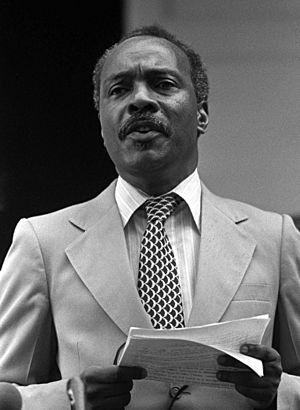Paul Scoon facts for kids
Quick facts for kids
Sir Paul Scoon
|
|
|---|---|

Sir Paul Scoon in 1983
|
|
| 2nd Governor-General of Grenada | |
| In office 30 September 1978 – 6 August 1992 |
|
| Monarch | Elizabeth II |
| Prime Minister | Sir Eric Gairy (1978–79) Maurice Bishop (1979–83) Bernard Coard (1983) Hudson Austin (1983) Nicholas Brathwaite (1983–84) Herbert Blaize (1984–89) Ben Jones (1989–90) Nicholas Brathwaite (1990–92) |
| Preceded by | Sir Leo de Gale |
| Succeeded by | Sir Reginald Palmer |
| Personal details | |
| Born | 4 July 1935 Gouyave, British Windward Islands (now Gouyave, Grenada) |
| Died | 2 September 2013 (aged 78) St. Paul's, Grenada |
| Nationality | Grenadian citizenship |
| Political party | Independent |
| Alma mater | University of Leeds University of Toronto |
Sir Paul Godwin Scoon (4 July 1935 – 2 September 2013) was an important politician from Grenada. He served as the Governor-General of Grenada from 1978 to 1992. This means he was the Queen's representative in Grenada. His time in office was very busy, especially because of big changes in the government and a major event in 1983 when other countries came to Grenada to help.
Contents
Early Life and Education
Paul Scoon was born on July 4, 1935, in Gouyave, a town on the west coast of Grenada. He went to local schools, including the Grenada Boys' Secondary School.
He studied at the University of London, the University of Leeds in England, and the University of Toronto in Canada. After finishing his studies, he returned to Grenada.
Scoon started his career as a teacher at the Grenada Boys' Secondary School. He then worked his way up in the government. He became the Chief Education Officer and later the Secretary to the Cabinet. This role meant he was the head of Grenada's Civil Service. In 1970, he received an award called the OBE.
Becoming Governor-General
In 1978, Queen Elizabeth II appointed Paul Scoon as the Governor-General of Grenada. He was chosen for this role by the Prime Minister at the time, Sir Eric Gairy.
However, the next year, a group called the New Jewel Movement took over the government. This group was led by Maurice Bishop, who had been one of Scoon's former students. Even though Scoon was briefly arrested, he was soon released.
The new government wanted Grenada to remain a constitutional monarchy. This meant they wanted to keep the Queen as the head of state, with the Governor-General representing her. Scoon and Bishop, the new leader, had a working relationship. Scoon did not agree with Bishop's political ideas, but he stayed in his role. He helped Grenada keep some stability and good relationships with countries like Canada and the United Kingdom.
Grenada's Difficult Time in 1983
In October 1983, Maurice Bishop was removed from power by another group within his own government. Sadly, Bishop and some of his closest ministers were killed on October 19, 1983. After this, a military council took strict control of the country.
Sir Paul Scoon, acting secretly, asked the United States and other Caribbean countries for help. He wanted them to come to Grenada to restore peace and order. Some people questioned if he had the full legal right to do this, but the countries that intervened said he did.
On October 25, a joint force from the U.S. and Caribbean countries arrived in Grenada. This event was called the invasion of Grenada.
One of the first things the invading forces did was to free Governor-General Scoon. A special unit of United States Navy SEALs went to his home. They got trapped there for a day, but eventually, Scoon, his family, his staff, and the SEALs were rescued by Marines.
The U.S. and Caribbean governments quickly said that Scoon was the only rightful authority in Grenada. A letter from Scoon, dated October 24, was released. In it, he asked for armed help. This letter was used to show that the invasion was not just the U.S. acting alone, but a group of countries working together.
After the invasion, Scoon became the temporary head of the government. He appointed an advisory council, which then named Nicholas Brathwaite as the temporary prime minister. New elections were held in 1984. Sir Paul Scoon retired from his position in 1992.
Later Life
After retiring, Sir Paul Scoon wrote a book called Survival for Service. In this book, he shared his personal experiences as Governor-General. He said that the letter asking for help was given to him after he was rescued, not written by him before. However, he did confirm that he had asked for the U.S. and Caribbean countries to intervene.
Sir Paul Scoon passed away on September 2, 2013. He had been a diabetic for many years.
See also
 In Spanish: Paul Scoon para niños
In Spanish: Paul Scoon para niños

